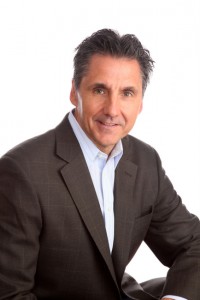By Leah Etling on October 25, 2012 in People
 Jim Young has taken his industry-leading commercial real estate technology conference, Realcomm, all over the globe to learn from the latest innovators. Now, the company is sending a mission to the final frontier – space.
Jim Young has taken his industry-leading commercial real estate technology conference, Realcomm, all over the globe to learn from the latest innovators. Now, the company is sending a mission to the final frontier – space.
In February 2013, a Russian Soyuz rocket will blast off for the International Space Station carrying a new round of science projects from around the globe, and a Realcomm and CALIT2–funded, high-school student designed experiment will be among them.
“Big ideas really do come out of the space industry, and those technologies that are being used in the space station probably will make their way to buildings over the next 10 to 15 years, a good example of that is Solar/LED lighting systems” noted Young. “Given that the ISS is the ‘most intelligent building in the universe,’ this fits very well with the mission and vision of Realcomm. “
But the real impetus behind this educational venture in outer space was motivated by a concerned dad’s desire to improve the education of his two daughters – and that of other American kids, too. During his first Realcomm international intelligent buildings tour in 2004, a trip to a classroom in China pushed Young to take a hard look at the U.S. education system, where it was falling short, and seek out opportunities for innovation and elevation that Realcomm and its community could fund. Over the years, the Realcomm community has donated significant amount of dollars to math and science.
The students who will devise and create the space experiment are part of Better Education for Women in Science and Engineering (BE Wise), part of the San Diego Science Alliance. Young’s oldest daughter Grace, 14, is a participant in the program, which pushes young women to see math and science as fun, exciting and rewarding career and educational opportunities.
For Jim Young, a rich and diverse career in technology and real estate began not with an academic opportunity, but a chance trip to Walt Disney World as a teen. From the bus window, he noticed the buildings under construction that would become EPCOT – Experimental Prototype Community of Tomorrow – originally intended to have thousands of permanent residents and be a model city of the future.
“If you look at some of the early designs of the city, they were phenomenal. They took urban cores and went all the way out to rural and had transportation systems that connected them. To this day, nobody’s really taken urban planning to that level. As a kid, I was intrigued and still am intrigued with some of Walt Disney’s early thoughts,” Young recounted. “After Walt died, that vision was lost.”
Young’s first professional job was at Wang Laboratories, where he was influenced by founder Dr. An Wang, an early technology innovator. At Wang Labs, he was exposed to ideas about business computing and data-driven decision making that were ahead of their time.
Deciding that his true passion was really real estate, Young moved to Sperry Van Ness, where he first merged his passions for technology and property transactions. In 1995, he started his own real estate technology consulting firm, working with clients like CB Richard Ellis, Irvine Company and Jones Lang LaSalle. But getting commercial firms to adopt tech savvy business practices wasn’t easy, and convincing executives of the true potential of using software for data analysis, forecasting trends, and improving building efficiency has been a never ending challenge in Young’s professional life.
He co-founded Realcomm in the hopes of pushing commercial, corporate and institutional real estate to more advanced technological heights, and the conference and associated seminars have educated the industry about the automation, intelligent design, and big data. The palpable excitement of the annual Realcomm conference, where thousands of commercial real estate professionals gather to share best practices and learn from developers and engineers, have fulfilled one part of Young’s mission.
But when it comes to actual adoption of available technology in commercial buildings across the nation, Young is frank. With a few notable exceptions (including Microsoft, Liberty Property Trust, Duke Realty, Boston Properties, GSA/PBS and a few others), use of advanced technology in new commercial buildings, or in commercial retrofits, is not yet the normal standard in the U.S. There is still much work to be done.
He compares the situation to placing a car from 30 years ago alongside a car built today, and then comparing an office building built in 1982 and one built today. Would one be able to see the difference in the building functionality? Would there be IP networks managing every device or system contained inside and sending data points back to a central management platform that monitors, corrects performance glitches and integrates into traditional real estate ERPs? Probably not.
“The automobile industry has embraced technology, to the point that Ford’s CEO says a car is simply a computer with wheels on it. That’s not the case in the building industry,” Young said. But the potential for improvement, like a large and complicated jigsaw puzzle whose image is not yet completely clear, keeps him moving forward.
“If we took full advantage of the analytics and visualization technologies that are out there, I think we’d have a much better handle on our asset class. And we wouldn’t get into trouble, the ups and downs, ups and downs. We’d be able to prevent that,” he said hopefully.
 Continuing to push for innovation involves not just continued education and advocacy, but politics, persuasion, and a detour to outer space. Young spent time during the late summer speaking to staffers in both the Obama and Romney camps, explaining the potential for creating green jobs and energy savings within commercial real estate. Realcomm’s events, now expanded to include the niche-focused IBcon and CoRE Tech, continue to push the dialogue among industry leaders forward. And sending an experiment to the International Space Station is an investment in the future.
Continuing to push for innovation involves not just continued education and advocacy, but politics, persuasion, and a detour to outer space. Young spent time during the late summer speaking to staffers in both the Obama and Romney camps, explaining the potential for creating green jobs and energy savings within commercial real estate. Realcomm’s events, now expanded to include the niche-focused IBcon and CoRE Tech, continue to push the dialogue among industry leaders forward. And sending an experiment to the International Space Station is an investment in the future.
“Forget about the tiny little experiment that may succeed or may fail, the fact that 15 high school girls were involved with a team that even attempted it should tweak their brains enough to give them confidence or inspiration that – who knows – maybe someday one of those girls will be up there,” Young said. It’s the kind of forward thinking that has made him a real estate technology visionary.


